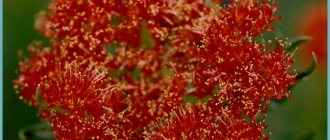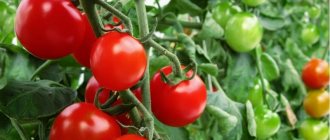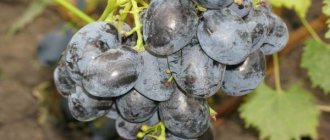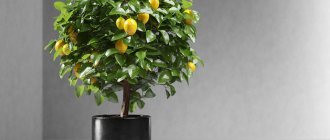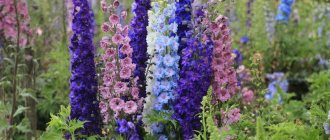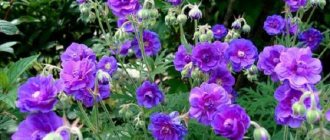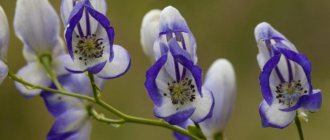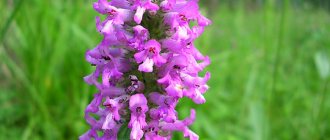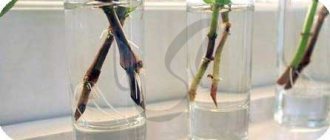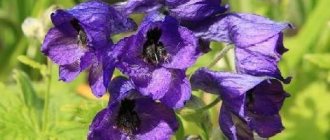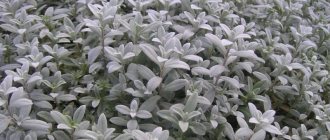Larkspur is a medicinal plant that is used to treat a number of diseases. It has found widespread use in folk medicine. The official name of this weed is “delphinium”. It is highly valued for its rich chemical composition, which includes many components important for health.
The plant contains small amounts of toxic substances
Description
Larkspur belongs to the Ranunculaceae. The family has many species, larkspur being one of the most popular representatives. This plant has more than 300 species in nature.
Larkspur field description includes botanical characteristics. This annual herbaceous crop can reach no more than 60 cm in height. It has a straight stem, from which thin branches extend in different directions. The leaves are characterized by pointed tips.
The plant blooms throughout the summer season
The flowers of this plant are colored white, pinkish, blue or purple. The fruit is a leaflet. It contains dark colored seeds inside. The grass is pollinated by bees.
Flowering continues from June to September.
Main types of larkspur
Larkspur is one of the three main, most common species of the genus of the same name. This list also includes tall and reticulate species.
The stem of this species reaches up to 4 m. It has alternate, long-petioled, rounded, five to seven-part leaves 3-7 cm long and 16 cm wide. Flowers of different shades of blue with spurs. The plant bears fruit in August-September. Distribution area: forests, ravines, river banks, mountains in the north and east of Europe, Siberia, Transbaikalia, and Central Asia.
Reticulata
Has stems up to 1 m in height. The leaves of this larkspur are alternate, about 5-10 cm long and 6-13 cm wide. They are palmate and dissected. The flowers are blue-violet with a corolla-shaped perianth and a long, elongated spur. The plant is widespread in the Southern Urals, Siberia, Kazakhstan, and the mountainous regions of Altai.
Related article: Red foxglove - beneficial properties, description
Spreading
Larkspur is common in many countries. The plant prefers soils rich in lime. It grows mainly in meadows, fields and along roadsides. Found in the steppe zone. In parks it is grown as an ornamental plant. This grass appears in a new place every year.
About a hundred species of this medicinal plant are found in Russia, most of them are poisonous.
Chemical composition
All parts of this plant contain a large number of alkaloids. During the flowering period their content increases. The main ones are: delcosin, delfamin, delatin, delphelin and others.
In addition to alkaloids, the plant boasts the presence of aconitic acid, flavonoids, zinc, manganese, iron, calcium, chromium, copper, selenium and many other trace elements.
The most toxic variety is Larkspur high
Composition and active ingredients of larkspur
The above-ground parts of the grass contain the following substances:
- flavonoids (quercetin, isorhamnetin, kaempferol);
- alkaloids (calcatrypine, delsimine, millictin);
- glycoalkoloid delphinidin;
- acotinic acid;
- organic acids;
Micro- and macroelements:
- Co (cobalt);
- Mg (magnesium);
- Zn (zinc);
- Ni (nickel);
- Ch (chrome);
- Se (selenium);
- Ba (barium);
- Pb (lead);
- Fe (iron).
The flowers contain the glycoside delphinin, alkaloids, acotinic acid, and pigments. The seeds contain fatty oil and alkaloids. The active ingredients of the medicinal herb are anthocyanin glycosides and flavonoids.
Pharmacological properties
The field component contained in larkspur reduces the tone of the muscular system and helps lower blood pressure. The plant has a diuretic effect. Can have a positive effect on the condition of patients suffering from malignant tumors.
The decoction helps relieve stomach pain. An infusion of flowers improves vision and heals the nervous system. In the form of compresses, it is applied to the sites of fractures and burns. The seeds help fight parasites in the body.
Larkspur helps normalize metabolism in the body, so it is also used by those who want to lose excess weight
It has an excellent diuretic effect and is used as a diuretic.
Medicinal properties of spur
The plant contains alkaloids, flavonoids, mineral elements and other substances. The medicinal properties of larkspur are widely used by humans.
Leaves and stems, which are collected and prepared in advance, are used as a diuretic. The flowers are part of expectorants.
Spur seeds have bactericidal properties. The plant will help relieve toothache and is effective against pneumonia. It is used to treat conjunctivitis.
Indications for use
Larkspur is prescribed to patients for many types of diseases. Most often it is taken for the following ailments:
- hypertension;
- fractures and bruises;
- osteochondrosis;
- disorders in the spinal cord;
- pathologies of the genitourinary system;
- intestinal disorders;
- abnormalities in the functioning of the stomach;
- some types of cancer;
- vision problems;
But we must remember that larkspur is not a medicine, but only a homeopathic remedy. You should not rely only on it and refuse drug treatment when necessary.
The use of larkspur in official medicine
In official medicine, curare-like active substances (muscle relaxants) are isolated from larkspur. They are used to relax muscles and skeletal muscles that may be blocked by motor nerves. The following medicinal products based on larkspur semi-bearded and larkspur reticularis are supplied to pharmacies:
- elatine;
- condelfin;
- delsemin;
- melliktin.
Doctors use preparations from this annual to treat the following serious diseases:
- Parkinson's disease;
- multiple sclerosis;
- spastic paralysis;
- arachnoiditis.
Larkspur seeds have a bactericidal effect
Contraindications for use
Since larkspur contains poison, you need to be careful with this plant so as not to get poisoned. Although the proportion of hazardous substances is very small, you should not exceed the recommended dosages of products prepared on the basis of this herb.
You should not self-medicate, so as not to harm your health even more. When storing prepared raw materials, you must ensure that children and pets do not have access to it.
Decoctions and infusions from this plant should not be taken by young children or pregnant women.
Methods of administration
There are many folk recipes for the treatment of various diseases that use larkspur. Describing each of them is a very labor-intensive process, but some can be given as an example:
- Boil 2 or 3 glasses of water, and then pour in one teaspoon of larkspur herb. Next, the container should be tightly closed, wrapped and placed in a warm place for 8 hours to infuse. The finished infusion must be filtered and drunk in 4 doses per day. This is how diseases of many internal organs are treated.
- For jaundice, dropsy and hernia, another recipe is used, according to which 2-3 tbsp. spoons of herbs should be poured with a glass of water and boiled for 10 minutes, after which the decoction should be filtered and its volume brought to 200 g with boiled water. Treatment is carried out by consuming 1 tbsp. l. three times a day. Externally, this infusion can be used to relieve pain from burns and tumors.
- For napara, which in modern conditions can be prepared in a thermos, take 20 g of larkspur and 1 liter of boiling water and leave overnight. Over the next day, drink 3 glasses before meals. This treatment mainly treats diseases of the genitourinary system, jaundice and conjunctivitis. It is also used externally.
- To treat cancer, 40 g of larkspur are infused with a liter of water in a water bath for 15 minutes, and then filtered. Three times a day, an hour before meals, take a third of a glass.
- By grinding larkspur seeds into powder, you can obtain an antiparasitic agent. The dosage of its administration is determined individually.
Larkspur is undoubtedly the most valuable gift to humanity, which is constantly faced with various kinds of diseases. However, one should not neglect the information that the plant contains a significant portion of toxic components. In treatment, they should never exceed the recommended doses, and if the plant grows nearby or is even used for decoration, care should be taken that all family members and pets do not have close contact with it.
How to recognize larkspur
In order not to be mistaken, you need to carefully study the distinctive features of this medicinal crop and consider the field larkspur photo. Describing the culture will also help you avoid making mistakes.
If you look closely at the flowers, you will notice a small growth on the sepals, resembling a spur. Flowers have 5 petals. The inflorescences are similar in shape to panicles
Application
In official medicine
Larkspur is included in some medicinal products actively used by official medicine in Russia.
The medicinal properties of this herb solve some important problems. Muscle relaxants necessary to relieve increased muscle tone were obtained from it. These substances help relax the whole body, relieve tension and pain.
Medicines are used in surgery. The most common of them are: elatin, melliktin, delsemin and condelfin. Such drugs in the form of tablets and ampoules are prescribed to patients with multiple sclerosis, head injuries, Parkinson's disease, lesions of the spinal cord, etc.
For domestic needs
This weed has a beautiful appearance during flowering. Therefore, it is sometimes used for decorative purposes. Flowers were used to dye fabrics. The plant also helps in controlling pests in the garden. The concentrated infusion repels beetles and butterflies that damage plantings.
Powder made from ground seeds helps get rid of insects at home. Effective against moths, cockroaches and flies
To treat all plants in your garden plot for preventive purposes, you need to make an infusion. A kilogram of the greenery of this plant is infused in a bucket of water for a day. Then add a little more laundry soap to the liquid. The resulting emulsion is sprayed onto the plantings.
To prepare the powder, dry raw materials are mixed with ash. The powder is used to pollinate garden crops. This type of work requires the use of a respirator to avoid poisoning. Previously, larkspur seed powder was used against lice, which was applied to the hair.
In folk medicine
The herb Larkspur has been used by people for medicinal purposes since ancient times. In ancient times in Greece, with the help of this herb they were saved from internal and external parasites.
Liver, kidney cancer
Larkspur in the form of a decoction alleviates the condition of these diseases; there are even cases of cure. To prepare it, you need to pour 2 tablespoons of dry crushed raw materials with a liter of boiling water. Then the mixture is kept in a water bath for another 15 minutes. The cooled mixture is filtered. Take three times a day before or after meals.
Larkspur decoction helps with liver cancer
Pneumonia
For pneumonia, 2 cups of boiling water will require a teaspoon of dry matter. The resulting emulsion must steep for at least 8 hours. The place for this should be chosen warm so that the decoction gains maximum effectiveness.
It is recommended to take the strained decoction 4 times a day after meals.
Pancreatitis
The plant is prescribed for problems with the pancreas. A spoonful of herbs should be poured with a liter of boiling water. Strain after an hour and drink a quarter glass three times a day.
Multiple sclerosis
A small amount of dry matter is infused in two glasses of boiling water for at least 8 hours. Take a third of a glass several times a day.
What can be cured
One of the poisonous components of larkspur has a relaxing effect on skeletal muscles, a depressant effect on the centers of the brain and lowers blood pressure. The discovery of this marked the beginning of its use in the treatment of hypertension, diseases associated with increased muscle tone, and impaired functioning of the brain and spinal cord.
Larkspur, the use of which in medicinal practice is very diverse, has a diuretic effect and is especially helpful for diseases of the genitourinary organs. It is very often used to treat kidney and stomach cancer. The decoction treats the digestive tract, as well as intestinal disorders, and relieves stomach pain.
It is believed that an infusion of larkspur flowers improves vision and helps in the fight against sclerosis and diseases of the nervous system. An infusion of the herb is used as a compress for fractures, and a decoction of the roots is used to treat burns and hernias. Sometimes a sore throat is treated by gargling a decoction of larkspur, and purulent inflammation of the eyes is treated with lotions. The seeds are used to prepare antiparasitic agents.
Article on the topic: Yellow water lily - beneficial properties, description
Is the toxic effect of larkspur on the body dangerous?
The toxins present in weed have a paralyzing effect on the human nervous system and muscles. The plant poses a threat to health and even life if the dosage is not observed.
The concentration of the poison depends on factors such as the time of year, the place where it grows, and the type of grass, larkspur. Garden varieties of this crop are considered to be the most dangerous.
Pollen is also toxic; if bees collect it to produce honey, such a product can be harmful.
Symptoms of larkspur poisoning
Poisoning with this plant leads to nausea and vomiting, and saliva is produced profusely. The victim feels a burning sensation in the throat and mouth. He may experience cramps in different muscle groups.
Later, muscle weakness increases. If help is not provided in time, the patient risks dying from respiratory arrest caused by the paralytic effect of the poison of this weed crop.
Direct contact of exposed skin with garden varieties of the plant often causes irritation and itching. It is best to work with it wearing thick gloves.
Help with poisoning
First aid to a poisoned person must be provided immediately. Gastric lavage helps a lot; you can take activated charcoal or Smecta to remove toxins.
You need to call an ambulance. The patient will need drugs such as tannin, which weaken the negative effects of the poison. Taking medications to support your heart will also be helpful.
The affected skin should be immediately rinsed thoroughly with water and bandaged with syntomycin emulsion.
Larkspur (consolidum field): application, description, traditional medicine
Larkspur, translated as Consolida regalis (Delphinium consolida), there are other names for this representative of the flora, for example, magnificent consolidation, royal consolidation, royal delphinium. The plant is a herbaceous annual; its height varies from 20 to 70 centimeters.
The stems of delphinium are branched-spread at the top, the leaves are double or triple-triple dissected into small narrow linear lobes, while the lower leaves are located on petioles. The bracts are quite short, the flowers are bright purple, much less often they are pale blue.
The fruit is represented by a bare leaflet, the seeds are covered with membranous short scales, which are arranged in transverse rows. Royal consolidum blooms from June to July inclusive.
The plant is found almost everywhere, excluding the northern regions and areas with the hottest climate.
• Part of seed larkspur used
The aerial parts of this plant are used, in particular the seeds, grass, and flowers, which are used for medicinal purposes in the preparation of various potions. Royal delphinium contains some alkaloids, it contains carbohydrates, anthocyanins, kaempferol and quercetin, as well as tannins and fatty oil, which is mainly found in the seeds.
• Collection and procurement of raw materials
It is worth knowing that this representative of the flora is considered quite poisonous, especially its seeds; therefore, when harvesting it, it is recommended to follow safety precautions, which will include the use of rubber gloves, and after collecting the raw materials, you need to wash your hands well with soap.
The grass is cut with scissors or pruning shears, after which it is cut into pieces and placed in a thin layer to dry on a tray, while the raw materials should be turned over daily so that they do not have time to become damp and spoil.
When the raw material is ready, it must be placed in pre-prepared cotton bags, which are stored in a ventilated place, while the shelf life of the grass should not be more than 24 months, during which time it is recommended to use the grass completely, as it will deteriorate later.
Seeds are harvested at the moment of their waxy ripeness. To do this, carefully cut off the top part of the grass and tie it into small sheaves, which are dried, after which they are threshed. Then the finished seeds are winnowed and, if necessary, dried on an open tray in a ventilated room.
• Growing larkspur
To grow this plant in your garden, you will need consolidum splendid seeds; it is recommended to sow them directly into open ground. However, when they are placed in prepared soil, they should be sprinkled with a thin layer of fertile soil, since they require darkness for germination.
It is worth saying that this plant is considered quite unpretentious, and frequent watering is only necessary for young plants while they are still in the active growth stage.
Medicinal potions are prepared from delphinium, in particular an infusion, which is often used by traditional healers for diseases of the gastrointestinal tract, as well as for some liver diseases.
This drug has a choleretic and diuretic effect on the body; it is prescribed for pneumonia, whooping cough, to stop an obsessive cough, and the infusion is also used to facilitate childbirth, with ascites, and for the proper regulation of the menstrual cycle.
An infusion prepared from the flowers and herb larkspur is used for headaches. In addition to internal use, this drug is also used externally as an eye wash in the presence of conjunctivitis, or lotions are made with it and applied to the organ of vision.
Article on the topic: Oxalis - beneficial properties, description
A medicinal ointment is prepared from this representative of the flora, which is used for external use, for example, in the presence of scabies.
To prepare an infusion based on the herb larkspur, you will need 20 grams of this raw material, and it should be finely crushed in a ceramic device in the form of a mortar and pestle, after which it is poured into an enamel container and a liter of boiling water is poured into it, and then everything is thoroughly mixed and left insist.
After forty minutes, you can begin filtering the infusion prepared from delphinium herb. To do this, you will need a fine strainer or gauze, which is first folded in two layers, after which the finished drug is poured through it into a clean container.
The prepared infusion should be taken 200 milliliters up to three times a day before meals. This drug should only be stored in the refrigerator, and its shelf life is limited to three days, after which it loses its medicinal properties.
To prepare an ointment based on consolid royale, you will need 10 grams of powder made from this medicinal herb, as well as 100 grams of lard. It is recommended to mix these components thoroughly. After which the finished mass is placed in a jar and used as a remedy for scabies, and you need to rub it into the skin three times a day.
The finished drug must be stored at a cool temperature, so you will need a refrigerator. The ointment should be used no later than two weeks from the date of preparation of the product.
We talked about the plant Larkspur sativum (Consolida arvensis), looked at its application, description, and how traditional medicine uses it. Before using potions prepared from larkspur seed, it is recommended that you first consult a qualified doctor, and only after his approval can this plant be used for medicinal purposes.
Royal delphinium can often be found in gardens and cottages, as it has decorative qualities and looks good when cut together with other representatives of the flora.
Cultural cultivation of larkspur and collection of raw materials
As a medicinal plant, larkspur is grown by many in garden plots. This culture is unpretentious and does not require special growing conditions. It can grow in any type of soil, but prefers limestone. Easily tolerates lack of moisture. It is resistant to cold weather.
Small children and animals should not be allowed to the planting site.
The plant does not get sick and is practically not attacked by pests. Larkspur reproduces by seeds
Harvesting the plant
All parts of the larkspur plant are used for medicinal purposes, except for the thick stems. The collected raw materials must be thoroughly dried before storing for long-term storage. A dark, well-ventilated room is suitable for this. The greens are laid out in one layer on paper or fabric.
The plant must dry completely. It is necessary to ensure access to oxygen, but the sun's rays should not fall on the grass. The seeds also have beneficial properties. They can be removed only after full ripening. After drying, the workpiece is stored in a dark and dry place.
It is best to touch this weed with gloves to prevent the development of an allergic reaction. After work, you must wash your hands thoroughly.
Collection and preparation of medicinal raw materials
In order to prepare a high-quality and effective medicinal product based on larkspur, it is necessary to properly prepare the raw materials.
When and where to collect larkspur
Larkspur must be picked away from highways, landfills, and industrial enterprises. Leaves, tops of stems and flowers are plucked off during the flowering period - from June to August. The seeds are in the waxy ripeness phase. The grass is first tied into sheaves, dried, and then threshed.
Procurement rules
Drying is carried out under a canopy in the fresh air away from sunlight.
You can also use balconies and loggias for drying, tying the grass in bunches in a vertical position or laying it out in one layer on a horizontal surface. When drying in a horizontal position, the plant must be stirred periodically.
You can also dry the grass in a special dryer or oven at a temperature of 40 degrees. The stems of flowers are removed before drying. The dry product should be stored in paper or fabric bags. Its shelf life is up to 2 years.
Recipes
Decoction for internal use
For internal use, larkspur is most often used in the form of a decoction. It's very easy to prepare. A couple of tablespoons of dried herb should be poured into one glass of boiling water.
Dried larkspur
Boil the mixture over low heat for another 10 minutes. Then it is filtered and diluted with water to bring it to a volume of 200 ml. Traditional healers recommend drinking this decoction at least three times a day, a tablespoon at a time.
This remedy is prescribed for dropsy, hernia and jaundice.
Preparation of medicinal products and instructions for their use
At home, decoctions, infusions, tinctures, ointments, powders and other healing agents are made from comfrey.
Powder
Powder applied to skin wounds
You will need the roots of larkspur or larkspur. Grind the raw materials using a coffee grinder to a homogeneous granular state. Externally, the powder is used for bleeding wounds, ulcers and other skin diseases, as well as in case of fractures. At the same time, it can be taken orally: mixed with honey in a ratio of 1:2 and eaten 1 tsp. three times a day, with a small amount of water.
To make juice you will need raw comfrey roots.
The juice is often extracted from the rhizomes. To do this, the roots extracted from the ground are washed, cut into pieces and grated on a fine grater. Then put the mass in gauze and squeeze it out.
If you mix the juice of field or tall comfrey with chamomile infusion in a 2:1 ratio, you will get a lotion. They wipe the face with acne and enlarged pores. In its pure form, the juice is used to treat wounds, abrasions, scratches and various inflammations. In addition, the juice is indicated for external bleeding - just drop it on the wound. When blood flows from the nose, make cotton swabs, soak them in larkspur juice and insert them into the nasal sinuses. Tampons are changed until the bleeding stops.
Juice from young leaves is used as a prophylactic against atherosclerosis. It is taken 1 tsp. three times a day.
Water infusion
To prepare an aqueous infusion you will need dried comfrey herb
For paralysis, diseases of the liver, kidneys and digestive system, an infusion is indicated, which is prepared as follows:
- Brew with boiling water (700–800 ml) 2–3 tsp. herbs larkspur field or reticularis.
- Cover the vessel and infuse the mixture for about 7 hours at room temperature.
Take half a glass of infusion 4 times a day.
Recipe for an infusion indicated for malignant liver tumors:
- Measure out 20–30 g of larkspur grass powder (field, reticularis), add half a liter of boiling water and place in a water bath.
- Keep the composition heated for a quarter of an hour, then remove and filter.
Drink the resulting infusion 70–80 ml daily before breakfast, lunch and dinner.
Larkspur root should be crushed before use.
The following infusion is made from the roots of comfrey: mix 2 tbsp in a thermos. l. crushed raw materials with 400 ml of boiling water and leave for 20 minutes without covering. Then seal and leave for at least another 7 hours. After filtering the liquid, take 100 ml 40 minutes before meals. The therapeutic course will be 45 days. This remedy is effective for chronic constipation, gastritis and stomach ulcers.
Root decoction
Typically, decoctions are used for lotions and compresses.
Method for preparing the decoction:
- Finely chop 120 g of field or comfrey root.
- Add 1 liter of boiling water.
- Place on low heat and boil for 15 minutes.
- Then filter.
The decoction is used as compresses for bleeding, fractures, sprained or torn ligaments, and joint problems.
Larkspur ointment effectively relieves any pain
The ointment can be prepared in several ways:
- A tablespoon of comfrey seeds is combined with interior fat (ratio 1:10). This mass is removed for 10–12 days in a dark place. Then it is used as a rub to relieve pain in the joints and spine. If you mix the seeds with beeswax, you get an effective composition for toothache.
- Fresh comfrey rhizomes are ground to a pulpy state. Then add lard or lard (1:1.5) and mix thoroughly. Infuse the mixture for about a day and transfer it to a glass container with an airtight lid. Store the ointment in the cold. This rubbing helps with any problems with the musculoskeletal system.
- Combine 150 g of dried larkspur root and 250 g of horse chestnut flowers. The mixture is ground in a mortar or coffee grinder to a powder state. Then add vodka or alcohol (5 tbsp) and mix. Then steam pork fat (400 g) and mix it with the previously made herbal mixture. At the end, boil the composition for 5 minutes. and strain through cheesecloth. It is used for trophic ulcers - applied in a thin layer to wounds, covered with cling film and tied with thick cloth. Make a compress at night and remove it in the morning.
